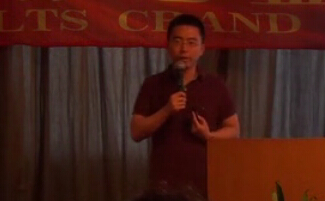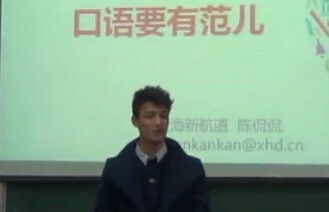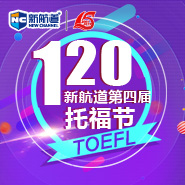雅思阅读之走向消失的香蕉
2014-04-02 16:04 供稿单位: 新航道
出国英语考试有哪些 雅思6.5是什么水平 雅思阅读评分标准 托福阅读评分标准 雅思和托福的区别
TEST 1
READING PASSAGE 3 (对应考试日期:2013年10月12日 2011年1月8日 2008年5月22日 2007年6月9日 2006年8月26日 2006年5月27日)
You should spend about 20 minutes on Questions 1-13 which are based on Reading Passage 1 below.
Going Bananas
The world’s favourite fruit could disappear forever in 10 years’ time.
The banana is among the world’s oldest crops. Agricultural scientists believe that the first edible banana was discovered around ten thousand years ago. It has been at an evolutionary standstill ever since it was first propagated in the jungles of South-East Asia at the end of the last ice age. Normally the wild banana, a giant jungle herb called Musa acuminata, contains a mass of hard seeds that make the fruit virtually inedible. But now and then, hunter-gatherers must have discovered rare mutant plants that produced seedless, edible fruits. Geneticists now know that the vast majority of these soft-fruited plants resulted from genetic accidents that gave their cells three copies of each chromosome instead of the usual two. This imbalance prevents seeds and pollen from developing normally, rendering the mutant plants sterile. And that is why some scientists believe the world’s most popular fruit could be doomed. It lacks the genetic diversity to fight off pests and diseases that are invading the banana plantations of Central America and the smallholdings of Africa and Asia alike.
In some ways, the banana today resembles the potato before blight brought famine to Ireland a century and a half ago. But it holds a lesson for other crops, too, says Emile Frison, top banana at the International Network for the Improvement of Banana and Plantain in Montpellier, France. The state of the banana, Frison warns, can teach a broader lesson: the increasing standardisation of food crops round the world is threatening their ability to adapt and survive.
The first Stone Age plant breeders cultivated these sterile freaks by replanting cuttings from their stems. And the descendants of those original cuttings are the bananas we still eat today. Each is a virtual clone, almost devoid of genetic diversity. And that uniformity makes it ripe for disease like no other crop on Earth. Traditional varieties of sexually reproducing crops have always had a much broader genetic base, and the genes will recombine in new arrangements in each generation. This gives them much greater flexibility in evolving responses to disease — and far more genetic resources to draw on in the face of an attack. But that advantage is fading fast, as growers increasingly plant the same few, high-yielding varieties. Plant breeders work feverishly to maintain resistance in these standardised crops. Should these efforts falter, yields of even the most productive crop could swiftly crash. “When some pest or disease comes along, severe epidemics can occur,” says Geoff Hawtin, director of the Rome-based International Plant Genetic Resources Institute.
The banana is an excellent case in point. Until the 1950s, one variety, the Gros Michel, dominated the world’s commercial banana business. Found by French botanists in Asia in the 1820s, the Gros Michel was by all accounts a fine banana, richer and sweeter than today’s standard banana and without the latter’s bitter aftertaste when green. But it was vulnerable to a soil fungus that produced a wilt known as Panama disease. “Once the fungus gets into the soil it remains there for many years. There is nothing farmers can do. Even chemical spraying won’t get rid of it,” says Rodomiro Ortiz, director of the International Institute for Tropical Agriculture in Ibadan, Nigeria. So plantation owners played a running game, abandoning infested fields and moving to “clean” land — until they ran out of clean land in the 1950s and had to abandon the Gros Michel. Its successor, and still the reigning commercial king, is the Cavendish banana, a 19th-century British discovery from southern China. The Cavendish is resistant to Panama disease and, as a result, it literally saved the international banana industry. During the 1960s, it replaced the Gros Michel on supermarket shelves. If you buy a banana today, it is almost certainly a Cavendish. But even so, it is a minority in the world’s banana crop.
Half a billion people in Asia and Africa depend on bananas. Bananas provide the largest source of calories and are eaten daily. Its name is synonymous with food.But the day of reckoning may be coming for the Cavendish and its indigenous kin. Another fungal disease, black Sigatoka, has become a global epidemic since its first appearance in Fiji in 1963. Left to itself, black Sigatoka — which causes brown wounds on leaves and premature fruit ripening — cuts fruit yields by 50 to 70 per cent and reduces the productive lifetime of banana plants from 30 years to as little as 2 or 3. Commercial growers keep Sigatoka at bay by a massive chemical assault.Forty sprayings of fungicide a year is typical. But even so, diseases such as black Sigatoka are getting more and more difficult to control. “As soon as you bring in a new fungicide, they develop resistance,” says Frison. “One thing we can be sure of is that the Sigatoka won’t lose in this battle.” Poor farmers, who cannot afford chemicals, have it even worse. They can do little more than watch their plants die. “Most of the banana fields in Amazonia have already been destroyed by the disease,” says Luadir Gasparotto, Brazil’s leading banana pathologist with the government research agency EMBRAPA. Production is likely to fall by 70 per cent as the disease spreads, he predicts. The only option will be to find a new variety.
But how? Almost all edible varieties are susceptible to the diseases, so growers cannot simply change to a different banana. With most crops, such a threat would unleash an army of breeders, scouring the world for resistant relatives whose traits they can breed into commercial varieties. Not so with the banana. Because all edible varieties are sterile, bringing in new genetic traits to help cope with pests and diseases is nearly impossible. Nearly, but not totally. Very rarely, a sterile banana will experience a genetic accident that allows an almost normal seed to develop, giving breeders a tiny window for improvement. Breeders at the Honduran Foundation of Agricultural Research have tried to exploit this to create disease-resistant varieties. Further backcrossing with wild bananas yielded a new seedless banana resistant to both black Sigatoka and Panama disease.
Neither Western supermarket consumers nor peasant growers like the new hybrid. Some accuse it of tasting more like an apple than a banana. Not surprisingly, the majority of plant breeders have until now turned their backs on the banana and got to work on easier plants. And commercial banana companies are now washing their hands of the whole breeding effort, preferring to fund a search for new fungicides instead. “We supported a breeding programme for 40 years, but it wasn’t able to develop an alternative to Cavendish. It was very expensive and we got nothing back,” says Ronald Romero, head of research at Chiquita, one of the Big Three companies that dominate the international banana trade.
Last year, a global consortium of scientists led by Frison announced plans to sequence the banana genome within five years. It would be the first edible fruit to be sequenced. Well, almost edible. The group will actually be sequencing inedible wild bananas from East Asia because many of these are resistant to black Sigatoka. If they can pinpoint the genes that help these wild varieties to resist black Sigatoka, the protective genes could be introduced into laboratory tissue cultures of cells from edible varieties. These could then be propagated into new, resistant plants and passed on to farmers.
It sounds promising, but the big banana companies have, until now, refused to get involved in GM research for fear of alienating their customers. “Biotechnology is extremely expensive and there are serious questions about consumer acceptance,”says David McLaughlin, Chiquita’s senior director for environmental affairs. With scant funding from the companies, the banana genome researchers are focusing on the other end of the spectrum. Even if they can identify the crucial genes, they will be a long way from developing new varieties that smallholders will find suitable and affordable. But whatever biotechnology’s academic interest, it is the only hope for the banana. Without it, banana production worldwide will head into a tailspin. We may even see the extinction of the banana as both a lifesaver for hungry and impoverished Africans and as the most popular product on the world’s supermarket shelves.
Questions 1-3
Complete the sentences below with NO MORE THAN THREE WORDS from the passage.
Write your answers in boxes 1-3 on your answer sheet.
1 The banana was first eaten as a fruit by humans almost _____ years ago.
2 Bananas were first planted in ______.
3 The taste of wild bananas is adversely affected by its ______.
Questions 4-10
Look at the following statements (Questions 4-10) and the list of people below.
Match each statement with the correct person, A-F.
Write the correct letter, A-F, in boxes 4-10 on your answer sheet.
NB You may use any letter more than once.
4 A pest invasion may seriously damage the banana industry.
5 The effect of fungal infection in soil is often long-lasting.
6 A commercial manufacturer gave up on breeding bananas for disease resistant species.
7 Banana disease may develop resistance to chemical sprays.
8 A banana disease has destroyed a large number of banana plantations.
9 Consumers would not accept genetically altered crop.
10 Lessons can be learned from bananas for other crops.
List of people
A Rodomiro Oritz
B David McLaughlin
C Emile Frison
D Ronald Romero
E Luadir Gasparotto
F Geoff Hawtin
Questions 11-13
Do the following statements agree with the information given in Reading Passage 1?
In boxes 11-13 on your answer sheet, write
TRUE if the statement agrees with the information
FALSE if the statement contradicts the information
NOT GIVEN if there is no information on this
11 The banana is the oldest known fruit.
12 The Gros Michel is still being used as a commercial product.
13 Banana is the main food in some countries.
Reading Passage 1. Going Bananas
题目详解
Questions 1-3
1. 题目答案一定为数字信息,同时根据顺序原则,答案应该出现在文章开头,于是定位于原文段第二句话“Agricultural scientists believe that the first edible banana was discovered around ten thousand years ago”,题目信息“eaten” 对应原文中的“edible”,所以答案为ten thousand。
2. 题目答案应该为一个地名,同时根据顺序原则,定位于段第三行中部“it was first propagated in the jungles of South-East Asia…”,题目信息“planted”对应原文中的“propagated”,所以答案为South-East Asia。
3. 利用细节信息“The taste of wild bananas”和顺序原则定位于段第四行“Normally the wild banana… contains a mass of hard seeds that make the fruit virtually inedible”,题目信息“adversely affected”对应原文中的“ virtually inedible”,所以答案为 hard seeds或seeds。
Questions 4-10
4. 利用细节信息“pest invasion”定位于第三段倒数第二行Geoff Hawtin 的观点“When some pest or disease comes along, severe epidemics can occur”,原文中的“severe epidemics can occur”对应题目信息“seriously damage the banana industry”,所以答案为F。
5. 利用细节信息“fungal infection in soil”定位于原文第四段第六行Rodomiro Ortiz 的观点“Once the fungus gets into the soil it remains there for many years”,原文中的“many years”对应题目信息“long-lasting”,所以答案为A。
6. 利用细节信息“A commercial manufacturer”定位于原文倒数第三段倒数第四行Ronald Romero 的观点“We supported a breeding programme for 40 years…”,题目信息“a commercial manufacturer”对应原文观点后面的“head of research at Chiquita, one of the Big Three companies that dominate the international banana trade”,所以答案为D。
7. 利用细节信息“chemical sprays”定位于原文第五段倒数第七行Emile Frison 的观点“As soon as you bring in a new fungicide, they develop resistance…”,原文中的“fungicide” 对应题目信息“chemical sprays”,所以答案为C。
8. 利用细节信息“destroyed a large number of banana plantations”定位于原文第五段倒数第四行Luadir Gasparotto 的观点“Most of the banana fields in Amazonia have already been destroyed by the disease”,所以答案为E。
9. 利用细节信息“consumers would not accept” 定位于原文一段第三行David McLaughlin 的观点“there are serious questions about consumer acceptance”,题目中的“genetically altered crop”对应本段句中的GM(genetic modification 的缩写),所以答案为B。
10. 利用细节信息“lessons for other crops”定位于原文第二段第二行Emile Frison 的观点“it holds a lesson for other crops, too”,所以答案为C。
Questions 11-13
11. 利用细节信息“oldest known fruit”定位于原文段句话“The banana is among the world’s oldest crops”。根据原文这个信息来判断,题目可能为True,也可能为False,所以答案为Not Given。
12. 利用细节信息“Gros Michel”定位于原文第四段倒数第二、三句话“During the 1960s, it replaced the Gros Michel on supermarket shelves. If you buy a banana today, it is almost certainly a Cavendish”。题目信息“still being used as a commercial product”与原文中的“it replaced the Gros Michel on supermarket shelves”以及“almost certainly a Cavendish”恰恰相反,所以答案为False。
13. 利用细节信息“main food”定位于原文第五段开头几句话“Half a billion people in Asia and Africa depend on bananas… Its name is synonymous with food”。题目信息与原文是同义表达,所以答案为True。
参考译文
走向消失的香蕉
世界上最受人们喜爱的水果可能会在未来十年消失。
香蕉是世界上最古老的水果之一。农业科学家认为,最早可食用的香蕉大约是在一万年前发现的。自从在一个冰川期末期在东南亚进行繁殖后,香蕉便一直处于进化停滞期。通常,野生香蕉,也就是一种名叫小果野蕉(Musa acuminata)的巨型丛林草本植物,它包含大量坚硬的籽,这些籽导致该品种不可食用。但狩猎采集者偶尔也会发现基因突变的稀有植物,它们可以结出无籽的、可食用的水果。基因学家目前了解到绝大部分结出软的水果的植物品种都是由基因突变造成的,这种突变会使植物细胞里出现三个被复制的染色体而不是通常的两个。这种不平衡阻止了种子和花粉的正常生长,使突变的植物不结果。这就是为什么一些科学家认为世界上的水果注定要消失。它缺乏基因多样性,这使得它难以抵抗那些入侵中美洲香蕉种植场和亚非小型农场的害虫和疾病。
法国蒙彼利埃的国际香蕉和大蕉改进联盟首席官艾米丽· 福瑞森认为,在某种程度上,今天的香蕉很像一个半世纪前的土豆,那时,枯萎病还未引发爱尔兰饥荒。它给其他农作物提供了一些借鉴。福瑞森还告诫道,香蕉的现状能让我们更清楚地认识到:全世界农作物的不断标准化正威胁着它们自身的适应和生存能力。
个石器时代的种植者通过重新栽培植物茎干上的切割部分种植了这些不结果的畸形植物。那些原本的切割部分的后代就是我们至今仍在吃的香蕉。每一个实际上都是克隆的,几乎没有基因多样性。那种一致性使得香蕉比任何其他作物都更容易受到疾病的危害。传统的有性生殖作物一直都有更宽阔的基因基础,这些基因在每一代都会以新的排列方式进行组合。这赋予了它们更大的灵活性来应对疾病,从而使它们在疾病来袭时,有更多的基因资源可以利用。但是随着种植者不断加大种植那些高产品种,这点优势正在急速减退。为了维持那些标准化作物的抵抗力,植物种植者便狂热地工作。如果这些努力失败了,那么,即使是最多产的作物,其产量也会迅速下降。罗马国际植物基因资源协会主任杰夫· 霍庭说,“当某种害虫或疾病来袭时,则可能会引发严重的流行疾病。”
香蕉就是一个极好的例子。直至20 世纪50 年代,大米歇尔(Gros Michel)这个品种一直是世界香蕉市场的领头军。该品种是19 世纪20 年代时由法国植物学家在亚洲发现的,曾一致被认为是一个良好的香蕉品种,比今天的普通香蕉要甜且醇厚。而且,即使食用了尚未成熟的大米歇尔,人们也不会尝到普通香蕉的那种苦涩。但它容易受到一种土壤真菌的侵害,这种土壤真菌会引发一种叫做巴拿马疾病的萎蔫病。尼日利亚伊巴丹的国际热带农业研究所主任罗得密罗·欧提斯说,“一旦真菌渗入土壤,就会存留很多年。农民对此束手无策。即使喷洒药剂也无法将其去除。”所以种植园主们玩了一场追逐游戏,他们不停地舍弃被感染的土地,迁移到“干净的”土地上去——直到20 世纪50 年代干净的土地被用尽了,不得不舍弃大米歇尔这个品种。它的接任者,也就是始终占领当前香蕉市场主导地位的卡文迪什(Cavendish)香蕉,是19 世纪时由英国人在中国南部发现的。该品种对巴拿马病有很强抵抗力,所以它确实解救了国际香蕉产业。20 世纪60 年代期间,它替代了大米歇尔香蕉,被摆到了超市的货架上。现在,如果你去买香蕉,那你几乎可以肯定会买到卡文迪什这个品种。但即便如此,在所有的世界香蕉品种中,它也只不过是个小类而已。
亚洲和非洲有5 亿人靠香蕉养活。香蕉可以提供最多的能量,人们每天都会吃。它的名字就是食物的同义词。但卡文迪什及其本土类似品种的末日可能快要来了。另外一种真菌疾病叫做黑叶斑病,自1963 年它次在斐济露面之后,就已经发展成为世界流行病。如果不做处理的话,这种可以造成树叶棕斑和水果早熟的黑叶斑病会使香蕉减产50%-70%,还会使香蕉作物的生产寿命由30 年减至2-3 年。商业种植者会采用大量化学手段牵制叶斑病。一年喷40 次杀真菌剂是非常典型的。但即便如此,像叶斑病这样的疾病正变得越来越难控制。福瑞森说,“一旦你引进一种新的杀真菌剂,它们就会产生抗体。我们可以确定的一点是,叶斑病将不会在此战中败北。”可怜的农民们买不起化学药剂,他们的处境会更糟,只能眼睁睁地看着他们的作物死去。政府调查机构EMBRAPA 和巴西香蕉病理学学者卢瓦迪· 高斯帕罗托说道,“亚马孙流域的大部分香蕉田地已经被疾病摧毁了。”他预测,当疾病传播开来,产量可能会下降70%。寻求一个新品种将会是的选择。
但是怎么寻找?几乎所有可食用的品种都抵御不了疾病,所以种植者不能只是换一种不同种类的香蕉。对大多数作物来说,这种威胁会激发一大批种植者,在世界范围内搜寻有抗体的相关作物,这种作物的遗传特征能使之被培育成为商业品种。对香蕉来说却不是这样的。因为所有可食用的品种都是不结果的,引进新的基因遗传特性来帮助抵抗害虫和疾病几乎是不可能的。几乎,但不是。在罕见的情况下,不结果的香蕉会经历一次基因突变,然后结出一个几乎正常的种子,从而给种植者带来了一点改进空间。洪都拉斯农业研究机构的种植者充分利用了这一点来创造一个对疾病有抵抗力的品种。另外,和野生香蕉的逆代杂交收获了一种能同时抵抗黑叶斑病和巴拿马萎蔫病的无籽香蕉。
西方国家中,超市的顾客和农作物种植者都不喜欢这个新的杂交品种。一些人指责说它的味道更像苹果。并不意外的是,如今,大部分种植者已经不再种这个品种而是去种其他更容易种植的品种了。商业香蕉公司也放下了所有的培植努力而不干了,他们更倾向于去探究新的杀真菌剂。在国际香蕉贸易中占支配地位的前三大公司之一的彻姬塔公司调查主任罗纳尔多· 罗梅罗说,“我们支持了一项培育计划长达40 年,但该项目却没能研制出卡文迪什的替代品。项目费用十分昂贵,但最终我们却一无所获。”
去年,一个由福瑞森领导的世界科学家协会宣布了在5 年内确定香蕉基因组顺序的计划。这将会是个被确定基因组顺序的可食用水果。好吧,应该说是几乎可食用。这个协会小组事实上会确定不能食用的东亚野生香蕉的基因顺序,因为这当中有很多对黑叶斑病有抵抗力。如果他们可以精确地找出能够帮助这些野生品种抵抗黑叶斑病的基因,那么就可以将这些有保护性的基因带进实验室,用于可食用品种的细胞组织培养。之后,这些研究成果便可以增殖成为新的、具有抵抗力的植物,然后就可以给农民种植了。
这听起来很有希望,但是直到现在,那些大型香蕉公司都拒绝参与GM 研究,他们担心因此疏远了客户。彻姬塔环境事务业务主任戴维· 麦克劳林说,“生物工学是非常昂贵的,取得客户的肯定也面临很多严峻的问题。”凭借着公司提供的少量资金,香蕉基因组研究员们把关注点放在了问题的另一端。即使他们可以辨认出关键性基因,但要研发出小农业主们认为合适的且能负担得起的新品种,他们依旧任重而道远。但不管生物工学的学术兴趣是什么,它是香蕉的希望。如果没有它,世界上的香蕉生产会越来越不景气。我们甚至会看到作为贫困饥饿的非洲人的救命稻草以及世界超市货架上的产品——香蕉的消失。
- 上一篇:如何突破雅思写作
- 下一篇:雅思写作急救室之“词汇小时代”

- 时时分享励志成长、英语学习、考试信息、留学动态等。《轻松学英文》致力于为广大英语学习爱好者提供青少英语、雅思、托福、SAT及留学规划等权威学习和资讯内容,力求帮助学生提高英语运用能力,在轻松快乐的环境中走向英语成功之道!
精彩专题
更多视频荟萃
更多
-
新航道姚骏鹏-雅思阅读高分攻略
时长:03-06

-
新航道陈侃侃-雅思口语要有范儿
时长:03-06

-
【3分钟学雅思】王大锤告诉你为啥药不能停
时长:01-12

-
【3分钟学雅思】全世界个感官餐厅
时长:01-12
热门文章
更多
-
8月31日雅思广州考机考初体验
选择机考模式的考生将通过机考模式参加听...









